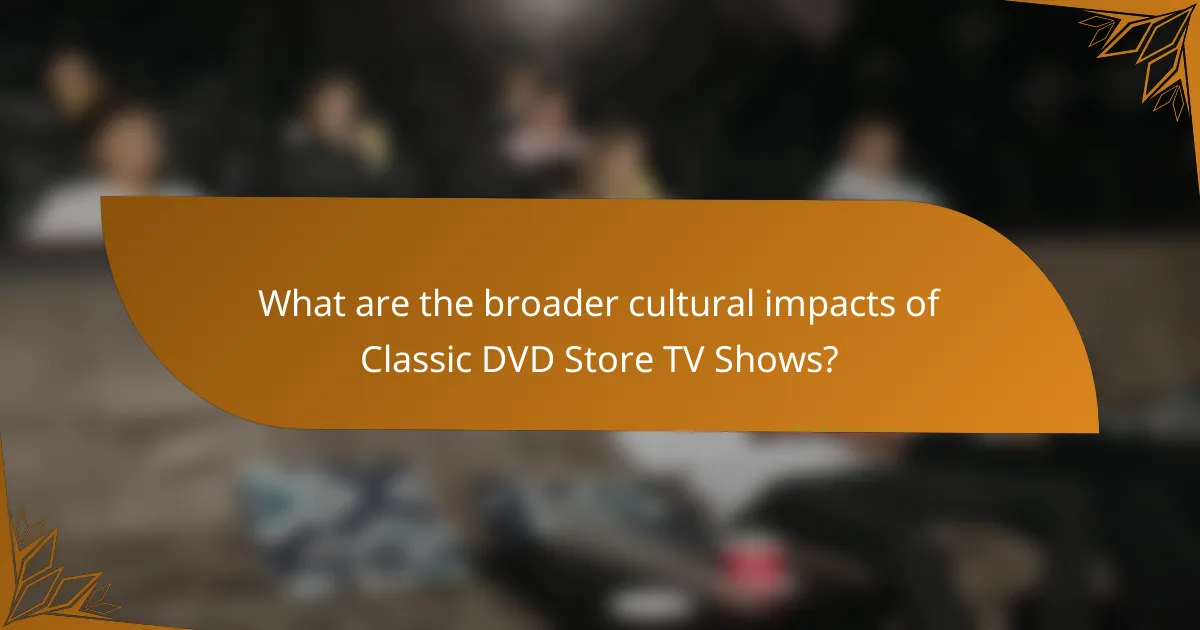Classic DVD Store TV shows are television series that have achieved lasting popularity and cultural significance, often available in DVD format. This article explores the enduring impact of these shows, highlighting how they reflect societal norms and trends while fostering nostalgia among viewers. Key examples such as “Friends,” “The X-Files,” and “Seinfeld” illustrate their iconic characters and memorable storylines. The accessibility of these shows on DVD has transformed viewing habits, encouraging binge-watching and creating a collectible culture. Additionally, the cultural influence of these series extends to shaping public perceptions on issues like race and identity, contributing to contemporary cultural landscapes.

What are Classic DVD Store TV Shows?
Classic DVD Store TV shows are television series that have gained enduring popularity and are often sold in DVD format. These shows typically feature iconic characters, memorable storylines, and significant cultural impact. Examples include series like “Friends,” “The X-Files,” and “Seinfeld.” These shows often reflect the social norms and trends of their time. They have loyal fan bases that continue to enjoy them through DVD collections. The availability of these shows on DVD allows for easy access and binge-watching. DVD releases often include special features, such as behind-the-scenes content and commentary, enhancing the viewing experience. Classic DVD Store TV shows remain a staple of popular culture, influencing new generations of viewers.
How did Classic DVD Store TV Shows emerge in popular culture?
Classic DVD Store TV Shows emerged in popular culture through the rise of home entertainment in the early 2000s. The transition from VHS to DVD technology allowed for higher quality viewing experiences. This shift made classic shows more accessible to audiences. Retailers dedicated to DVDs began to stock these shows extensively. Fans sought out their favorite series from past decades. This demand led to the creation of DVD collections and box sets. Marketing strategies targeted nostalgic viewers, emphasizing the cultural significance of these shows. Consequently, classic TV shows gained renewed popularity and became a staple in home media collections.
What historical events influenced the rise of these shows?
The rise of classic DVD store TV shows was influenced by several historical events. The advent of home video technology in the late 1970s allowed viewers to watch shows on demand. This shift changed how audiences consumed television content. The 1980s saw an increase in cable television, expanding access to diverse programming. The launch of the DVD format in the late 1990s made it easier to collect and store shows. The nostalgia for past television eras grew as audiences sought familiar content during the early 2000s. The internet boom facilitated the distribution of classic shows through online platforms. These events collectively shaped the landscape for classic TV shows in DVD stores.
How did the format of DVD influence the consumption of TV shows?
The DVD format significantly influenced the consumption of TV shows by enabling binge-watching. DVDs allowed viewers to watch entire seasons at their own pace. This format eliminated the constraints of weekly episode releases. Consequently, audiences could engage with narratives more deeply. The convenience of DVDs led to increased home viewing. Research indicates that DVD sales surged in the early 2000s. This surge coincided with a rise in the popularity of TV show box sets. The ability to own complete seasons changed viewer habits. It fostered a culture of collecting and re-watching favorite series. This shift ultimately transformed how TV shows were marketed and consumed.
Why are Classic DVD Store TV Shows significant in cultural discussions?
Classic DVD Store TV shows are significant in cultural discussions because they reflect societal values and historical contexts. These shows often capture the zeitgeist of their respective eras, offering insights into the norms and issues of the time. For example, series like “M*A*S*H” addressed the complexities of war and morality, influencing public opinion. They also serve as a medium for nostalgia, connecting viewers to their past experiences and shared memories. Moreover, classic shows contribute to ongoing dialogues about representation and diversity in media. Their availability on DVD allows for continued analysis and appreciation, fostering a deeper understanding of cultural evolution. Ultimately, these shows shape collective memory and inform contemporary cultural narratives.
What themes and messages are prevalent in these shows?
Prevalent themes in classic DVD store TV shows include friendship, resilience, and the pursuit of dreams. These shows often depict characters overcoming obstacles together. They emphasize the importance of community and support systems. Many stories highlight personal growth and self-discovery. Themes of nostalgia and cultural identity are also common. These shows reflect societal values and issues of their time. They often tackle moral dilemmas and ethical questions. The messages resonate with audiences, promoting hope and connection.
How do these shows reflect societal values and norms of their time?
Classic DVD store TV shows reflect societal values and norms of their time through their themes and character portrayals. For instance, shows from the 1950s often emphasized traditional family structures and gender roles. In contrast, 1970s sitcoms began to address social issues like race and gender equality. These shifts illustrate changing public sentiments and cultural priorities.
The portrayal of characters often mirrored contemporary societal expectations. For example, the strong female leads in the 1990s signified a growing acceptance of women’s independence. Similarly, the inclusion of diverse characters represented a response to increasing multiculturalism.
Viewers connected with these narratives, validating their own experiences and beliefs. Shows like “All in the Family” tackled controversial topics such as racism and sexuality, reflecting the era’s social debates. This connection between television content and societal norms demonstrates how these shows acted as both mirrors and influencers of cultural change.

How did Classic DVD Store TV Shows shape viewer experiences?
Classic DVD Store TV shows shaped viewer experiences by providing access to beloved series and fostering nostalgia. Viewers could revisit favorite episodes at their convenience. This accessibility allowed for binge-watching, changing how audiences consumed content. The physicality of DVDs also created a collectible culture among fans. Special features and commentaries enhanced viewer engagement with the shows. Research indicates that nostalgia can positively affect mood and well-being, reinforcing viewer attachment to these series. Consequently, Classic DVD Store TV shows contributed to a deeper emotional connection to television programming.
What role do Classic DVD Store TV Shows play in nostalgia for viewers?
Classic DVD Store TV Shows evoke nostalgia for viewers by serving as a bridge to their past. These shows often represent formative experiences and shared cultural moments. Viewers frequently associate them with specific times in their lives, such as childhood or adolescence. The familiarity of characters and storylines can trigger memories and emotions tied to those periods.
Research indicates that nostalgia can enhance mood and foster social connections. A study published in the journal “Emotion” found that nostalgic reflection can increase feelings of belonging and continuity in life. Classic TV shows, available on DVD, allow viewers to revisit these cherished memories at their convenience. This accessibility reinforces the emotional bond viewers have with the content, solidifying its role in their nostalgic experiences.
How do these shows evoke memories of the past?
Classic DVD store TV shows evoke memories of the past through nostalgic storytelling and familiar characters. These shows often reflect cultural norms and values from their original airing periods. Viewers connect emotionally with the themes and situations portrayed. Iconic catchphrases and memorable scenes trigger personal recollections. Music and soundtracks from these shows also play a significant role in evoking nostalgia. Studies indicate that auditory stimuli can enhance memory recall. Furthermore, the visual aesthetics of the shows, including fashion and set design, transport viewers back to specific eras. Collectively, these elements create a powerful sense of reminiscence for audiences.
What emotional connections do viewers form with characters and storylines?
Viewers form deep emotional connections with characters and storylines through empathy and identification. These connections often arise when viewers see aspects of their own lives reflected in the characters’ experiences. For instance, characters facing challenges can evoke feelings of hope and resilience.
Storylines that explore themes of love, loss, and triumph resonate strongly with audiences. Research indicates that viewers can experience emotional catharsis when they relate to character struggles. This can lead to increased engagement and investment in the narrative.
Studies show that characters who exhibit vulnerability often foster stronger connections. Viewers may feel a sense of companionship with these characters, enhancing their emotional experience. Overall, the interplay of character development and relatable story arcs creates significant emotional ties for viewers.
How have Classic DVD Store TV Shows influenced modern television?
Classic DVD Store TV shows have significantly influenced modern television by shaping narrative structures and character development. These classic shows often featured complex story arcs that spanned multiple episodes or entire seasons. This approach laid the groundwork for today’s serialized storytelling in popular series.
Additionally, classic shows introduced the concept of character-driven plots, allowing audiences to connect deeply with characters over time. This trend is evident in modern dramas and comedies, where character evolution is central to the narrative.
Moreover, the availability of classic shows on DVD has allowed new generations to discover and appreciate these series. This revival has influenced current programming choices, encouraging networks to produce content that pays homage to these classics.
The impact is also seen in the resurgence of sitcom formats and multi-camera setups, which were popularized by classic shows. These formats remain prevalent in contemporary television.
In summary, classic DVD Store TV shows have played a crucial role in shaping the narrative techniques, character focus, and stylistic choices of modern television.
What elements from these shows are evident in contemporary programming?
Contemporary programming reflects elements from classic DVD store TV shows. One evident element is the use of serialized storytelling. This format allows for deeper character development over multiple episodes. Another element is the incorporation of ensemble casts. Shows like “Friends” and “The Office” popularized this structure, influencing modern series. Additionally, humor styles have evolved but often echo the comedic timing found in classic sitcoms. Themes of friendship and family dynamics remain prevalent in today’s programming. Furthermore, nostalgia plays a significant role, with reboots and spin-offs of classic shows gaining popularity. Streaming platforms also emphasize binge-watching, a behavior rooted in the viewing habits of classic series. These elements showcase the lasting influence of classic TV on contemporary media.
How have viewer expectations changed due to these classic shows?
Viewer expectations have evolved significantly due to classic shows. These shows set high standards for storytelling and character development. Audiences now anticipate complex narratives and well-rounded characters. Classic shows often featured innovative formats and themes. This has influenced viewers to seek originality in contemporary programming. Additionally, the binge-watching culture emerged from the availability of classic shows on DVD. As a result, viewers expect immediate access to entire seasons. Viewer engagement has also increased, with audiences desiring interactive experiences. Overall, the impact of classic shows has reshaped modern television consumption patterns.

What are the broader cultural impacts of Classic DVD Store TV Shows?
Classic DVD Store TV Shows have significantly influenced cultural norms and societal values. These shows often reflect and shape public perceptions of various issues. They serve as a cultural touchstone, fostering shared experiences among viewers. Many classic shows address themes of family, friendship, and social justice, impacting viewers’ beliefs and behaviors. For instance, shows like “Friends” and “The Fresh Prince of Bel-Air” have shaped conversations about race and identity. Their popularity has led to the resurgence of nostalgia, impacting fashion and language. Additionally, these shows have contributed to the rise of binge-watching culture, changing how audiences consume media. Overall, Classic DVD Store TV Shows play a crucial role in shaping contemporary cultural landscapes.
How do these shows contribute to collective memory and identity?
Classic DVD store TV shows contribute to collective memory and identity by creating shared cultural references. These shows often reflect societal values and norms of their time. They serve as a common ground for discussions among viewers. Iconic moments from these shows become part of popular culture. For example, phrases and scenes are frequently quoted in everyday conversations. This shared knowledge fosters a sense of belonging among fans. Additionally, nostalgia plays a significant role in how these shows shape personal and collective identities. Studies show that nostalgia can enhance social connectedness and well-being. Overall, classic TV shows help form a collective memory that influences identity across generations.
In what ways do they shape cultural narratives and discussions?
Classic DVD store TV shows shape cultural narratives and discussions by influencing societal norms and values. These shows often reflect and challenge contemporary issues, allowing audiences to engage in critical conversations. For example, “Friends” popularized themes of friendship and urban living, impacting social dynamics in the 1990s. Similarly, “The Simpsons” satirizes American culture, prompting discussions on politics and family life. The accessibility of these shows on DVD allows for nostalgia-driven viewing, reinforcing cultural memories. Additionally, they serve as reference points in media, impacting new content creation and audience expectations. Their enduring popularity demonstrates their role in shaping collective cultural identity.
How do these shows impact the representation of different communities?
Classic DVD store TV shows significantly impact the representation of different communities. These shows often depict diverse characters and storylines that reflect various cultural backgrounds. For example, shows like “The Fresh Prince of Bel-Air” showcase African American experiences, influencing public perceptions. Similarly, “Will & Grace” played a crucial role in introducing [censured] characters to mainstream audiences. Research indicates that representation in media can lead to greater acceptance and understanding of different cultures. A study published in the Journal of Communication found that positive portrayals in television can reduce stereotypes. Therefore, classic TV shows contribute to shaping societal views on diversity and inclusion.
What lessons can we learn from Classic DVD Store TV Shows today?
Classic DVD Store TV shows teach us the importance of storytelling and character development. These shows often featured complex characters that audiences connected with emotionally. They tackled social issues relevant to their time, providing commentary and reflection on cultural norms. The humor and creativity in these shows remain influential in today’s television landscape. They demonstrate the value of originality and creativity in content creation. Nostalgia plays a significant role in viewer engagement, as many people fondly remember these shows. The format of episodic storytelling has shaped modern series structures, emphasizing character arcs over time. Overall, these shows highlight the enduring power of well-crafted narratives in shaping culture and entertainment.
How can these shows inform current storytelling practices?
Classic DVD store TV shows can inform current storytelling practices by providing established narrative structures and character development techniques. These shows often utilize episodic storytelling, allowing for deep character arcs and ongoing plotlines. Viewers appreciate the balance of humor and drama, which can enhance emotional engagement. The use of cliffhangers encourages audience retention and anticipation for future episodes.
Additionally, these shows frequently explore complex social themes, reflecting societal issues that resonate with audiences. For instance, shows like “The X-Files” tackled themes of trust and conspiracy, which remain relevant today. By analyzing audience reactions to these classic narratives, current creators can identify successful tropes and themes.
Furthermore, the cultural references and nostalgic elements of these shows can be leveraged to connect with contemporary viewers. This blend of old and new storytelling techniques can result in innovative and relatable content.
What best practices can be derived from the success of these shows?
Best practices from the success of classic DVD store TV shows include strong character development and engaging storytelling. These shows often feature well-defined characters that resonate with audiences. Memorable story arcs keep viewers invested over multiple seasons. They also incorporate humor and relatable themes to enhance viewer connection. High production quality contributes to a polished viewing experience. Effective marketing strategies, such as targeted promotions, increase visibility and attract diverse audiences. Finally, leveraging nostalgia can strengthen audience loyalty and drive interest in classic series.
Classic DVD Store TV Shows are television series that have achieved lasting popularity and cultural significance, often available in DVD format. This article explores their emergence in popular culture, historical influences, and the impact of the DVD format on viewing habits. It also examines the themes, societal reflections, and emotional connections these shows foster among viewers. Additionally, the article discusses how classic shows shape modern television and cultural narratives, highlighting their role in representation and collective memory. Overall, it provides insights into the broader cultural implications of these iconic series.


